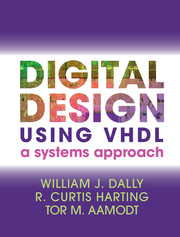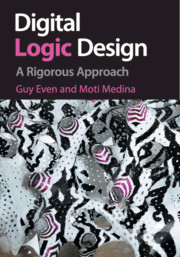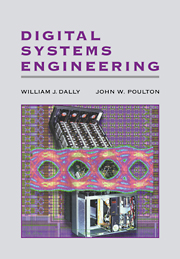Digital Design
This introductory textbook provides students with a system-level perspective and the tools they need to understand, analyze and design digital systems. Going beyond the design of simple combinational and sequential modules, it shows how such modules are used to build complete systems, reflecting real-world digital design. All the essential topics are covered, including design and analysis of combinational and sequential modules, as well as system timing and synchronization. It also teaches how to write Verilog HDL in a productive and maintainable style that enables CAD tools to do much of the tedious work. A complete introduction to digital design is given through clear explanations, extensive examples and online Verilog files. The teaching package is completed with lecture slides, labs and a solutions manual for instructors. Assuming no previous digital knowledge, this textbook is ideal for undergraduate digital design courses that will prepare students for modern digital practice.
- Takes a system-level approach that better prepares students for modern digital design in the real world
- Includes all the essential topics, from composition of combinational modules to system timing and synchronization
- Teaches students how to write Verilog HDL in a productive and maintainable style that enables modern CAD tools to do much of the tedious work
Reviews & endorsements
'Dally and Harting blend circuit and architecture design in a clear and constructive manner on the basis of their exceptional experience in digital design. Students will discover a modern and effective way to understand the fundamental underpinning of digital design, by being exposed to the different abstraction levels and views of computing systems.' Giovanni De Micheli, École Polytechnique Fédérale de Lausanne
'Bill and Curt have combined decades of academic and industry experience to produce a textbook that teaches digital system design from a very practical perspective without sacrificing the theoretical understanding needed to train tomorrow's engineers. Their approach pushes students to understand not just what they are designing but also what they are building. By presenting key advanced topics, such as synthesis, delay and logical effort, and synchronization, at the introductory level, this book is in the rare position of providing both practical advice and deep understanding. In doing so, this book will prepare students well even as technology, tools, and techniques change in the future.' David Black-Schaffer, Uppsala University
'Everything you would expect from a book on digital design from [Professor] Dally. Decades of practical experience are distilled to provide the tools necessary to design and compose complete digital systems. A clear and well written text that covers the basics and system-level issues equally well. An ideal starting point for the microprocessor and SoC designers of the future!' Robert Mullins, University of Cambridge and the Raspberry Pi Foundation
'This textbook sets a new standard for how digital system design is taught to undergraduates. The practical approach and concrete examples [provide] a solid foundation for anyone who wants to understand or design modern complex digital systems.' Steve Keckler, University of Texas, Austin
'This book not only teaches how to do digital design, but more importantly shows how to do good design. It stresses the importance of modularization with clean interfaces, and the importance of producing digital artifacts that not only meet their specifications, but which can also be easily understood by others. It uses an aptly chosen set of examples and the Verilog code used to implement them … It includes a section on the design of asynchronous logic, a topic that is likely to become increasingly important as energy consumption becomes a primary concern in digital systems … The final appendix on Verilog coding style is particularly useful. This book will be valuable not only to students, but to practitioners in the area. I recommend it highly.' Chuck Thacker, Microsoft
'A terrific book with a terrific point of view of systems. Everything interesting - and awful - that happens in digital design happens because engineers must integrate ideas from bits to blocks, from signals to CPUs. The book does a great job of focusing on the important stuff, moving from foundations to systems, with the right amount of HDL (Verilog) focus to make everything practical and relevant.' Rob A. Rutenbar, University of Illinois, Urbana-Champaign
Product details
November 2012Hardback
9780521199506
636 pages
254 × 195 × 31 mm
1.54kg
469 b/w illus. 68 tables 639 exercises
Temporarily unavailable - available from TBC
Table of Contents
- Part I. Introduction:
- 1. The digital abstraction
- 2. The practice of digital system design
- Part II. Combinational Logic:
- 3. Boolean algebra
- 4. CMOS logic circuits
- 5. Delay and power of CMOS circuits
- 6. Combinational logic design
- 7. Verilog descriptions of combinational logic
- 8. Combinational building blocks
- 9. Combinational examples
- Part III. Arithmetic Circuits:
- 10. Arithmetic circuits
- 11. Fixed- and floating-point numbers
- 12. Fast arithmetic circuits
- 13. Arithmetic examples
- Part IV. Synchronous Sequential Logic:
- 14. Sequential logic
- 15. Timing constraints
- 16. Datapath sequential logic
- 17. Factoring finite-state machines
- 18. Microcode
- 19. Sequential examples
- Part V. Practical Design:
- 20. Verification and test
- Part VI. System Design:
- 21. System-level design
- 22. Interface and system-level timing
- 23. Pipelines
- 24. Interconnect
- 25. Memory systems
- Part VII. Asynchronous Logic:
- 26. Asynchronous sequential circuits
- 27. Flip-flops
- 28. Metastability and synchronization failure
- 29. Synchronizer design
- Appendix A. Verilog coding style
- References
- Index of Verilog modules
- Subject index.






